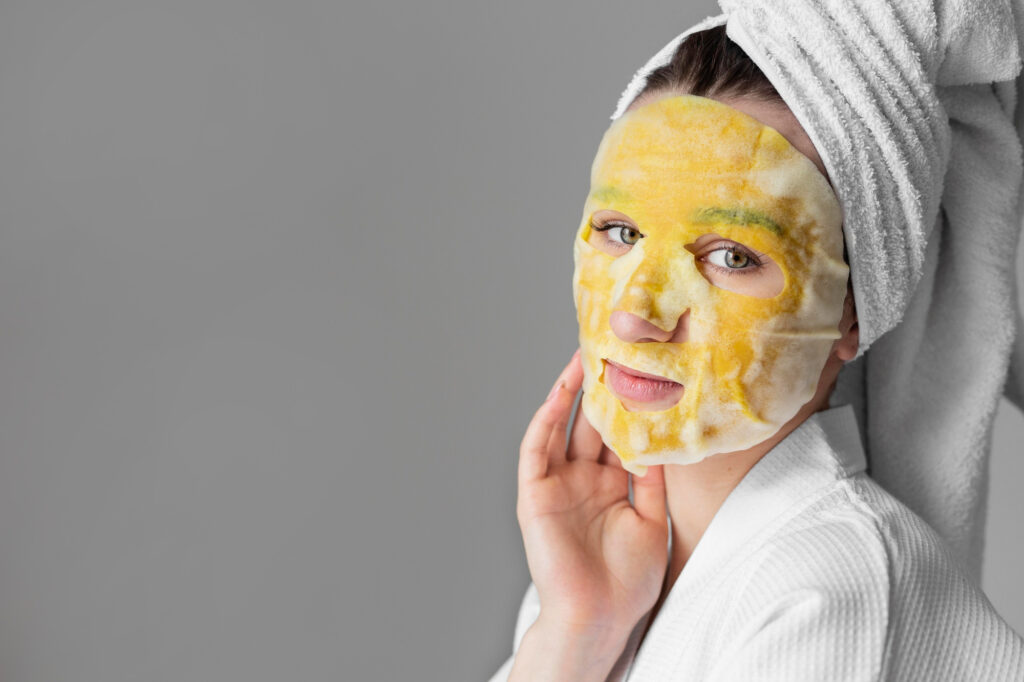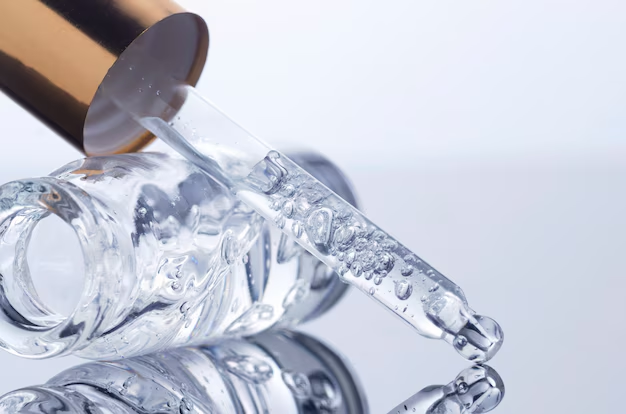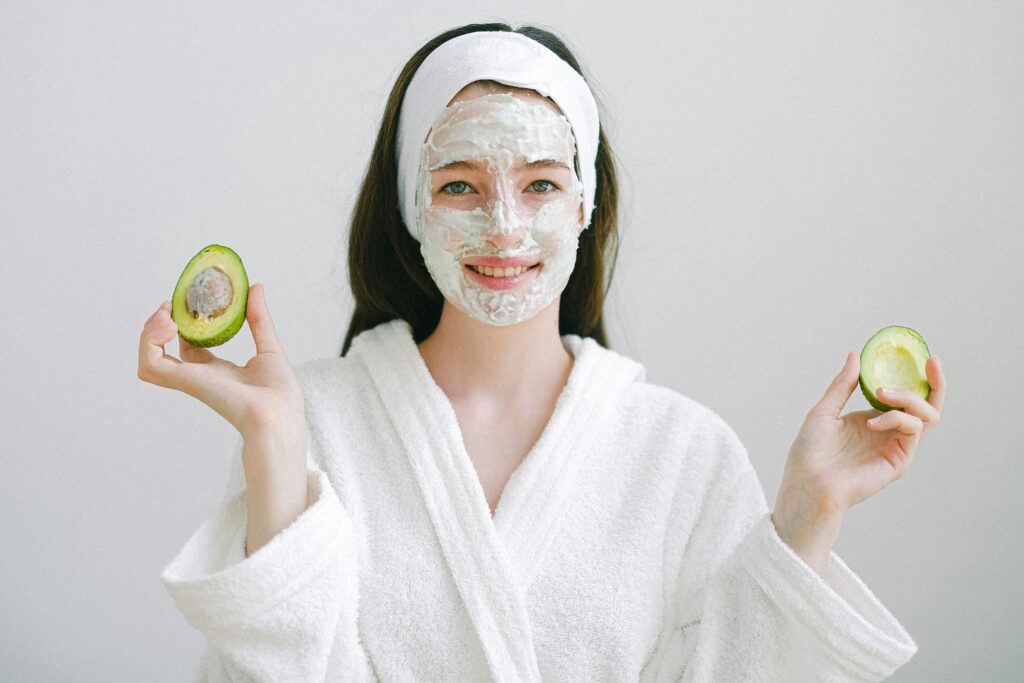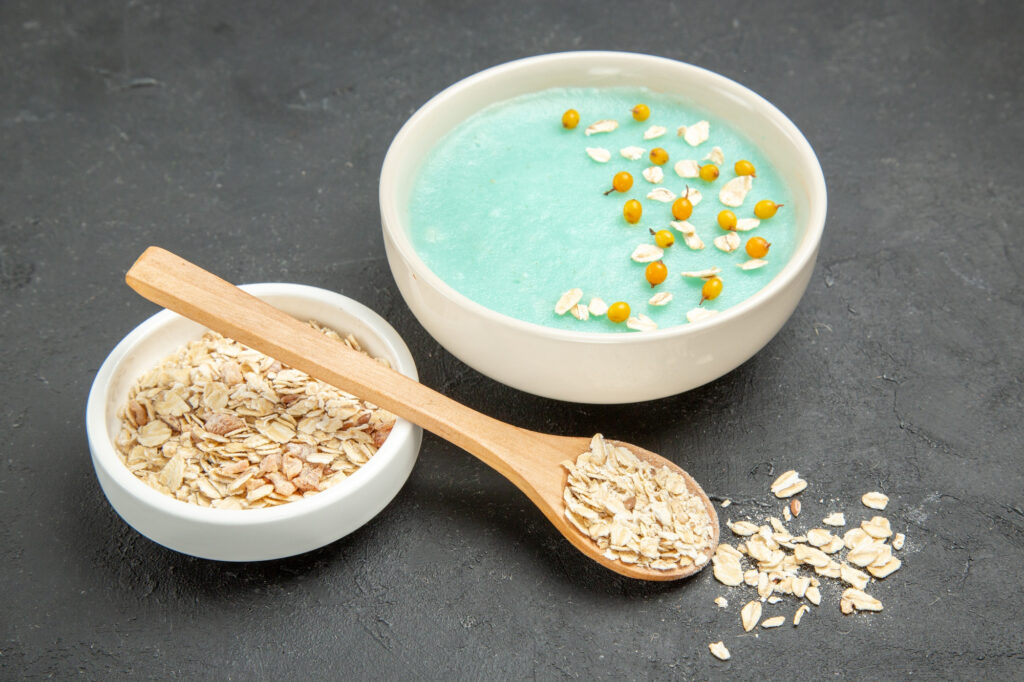
Feeling like your skin is a dry, flaky desert? You’re not alone! Dryness is a common skin concern, especially during harsh weather conditions or as we age. But fear not, there’s a superhero ingredient that can come to the rescue: hyaluronic acid!
Hyaluronic acid is a naturally occurring substance in our skin that acts like a magnet for moisture. It plumps up skin cells, leaving your face feeling dewy, hydrated, and refreshed. And the best part? You can create fantastic hydrating masks right at home using hyaluronic acid and other natural ingredients!
This article explores 10 easy, DIY hyaluronic acid mask recipes you can whip up in your kitchen. These masks are perfect for all skin types, but especially beneficial for those with dry, dehydrated skin.
Also Read: 04 DIY Beauty Products with Sustainable Ingredients: Pamper Yourself Naturally
10 Best DIY Hydrating Hyaluronic Acid Masks
Before we dive into the recipes, let’s gather some essentials:
- Hyaluronic Acid Powder: This is the star ingredient! You can find pure hyaluronic acid powder online or at some specialty beauty stores.
- Mixing Bowl and Spoon: For combining your mask ingredients.
- Applicator Brush (optional): This can help you apply the mask more evenly to your face, but your fingers work just fine too!
- Washcloth: For removing the mask after use.
Important Note: Before applying any new mask to your face, do a patch test on a small area of your skin, like the inner bend of your elbow. Wait 24 hours to see if you experience any irritation.
Now, let’s get mixing!
Simple Hyaluronic Acid and Water Mask:
This is a basic yet effective way to experience the hydrating power of hyaluronic acid.
Ingredients:
-
- 1/2 teaspoon hyaluronic acid powder
- 2 tablespoons water

Instructions:
-
- In your mixing bowl, combine the hyaluronic acid powder and water.
- Let the mixture sit for 5 minutes to allow the hyaluronic acid to activate.
- Apply the mask to your clean, dry face, avoiding the eye area.
- Leave the mask on for 15-20 minutes.
- Rinse the mask off with lukewarm water and pat your face dry.
Soothing Aloe Vera and Hyaluronic Acid Mask:
Aloe vera is known for its calming and hydrating properties. This mask is perfect for dry, irritated skin.
Ingredients:
-
- 1/2 teaspoon hyaluronic acid powder
- 2 tablespoons aloe vera gel
- 1 tablespoon honey
Instructions:
-
- In your mixing bowl, combine all ingredients and mix well.
- Apply the mask to your clean, dry face, avoiding the eye area.
- Leave the mask on for 15-20 minutes.
- Rinse the mask off with lukewarm water and pat your face dry.
Also Read: 10 Best GMO-Free Skin-Friendly Solutions: Pamper Your Skin Naturally!
Nourishing Avocado and Hyaluronic Acid Mask:
Avocados are rich in healthy fats and vitamins, making them a fantastic ingredient for dry skin.
Ingredients:
-
- 1/2 teaspoon hyaluronic acid powder
- 1/4 ripe avocado, mashed
- 1 tablespoon olive oil

Instructions:
-
- In your mixing bowl, mash the avocado until smooth.
- Add the hyaluronic acid powder and olive oil and mix well.
- Apply the mask to your clean, dry face, avoiding the eye area.
- Leave the mask on for 15-20 minutes.
- Rinse the mask off with lukewarm water and pat your face dry.
Brightening Honey and Hyaluronic Acid Mask:
Honey has natural antibacterial properties and can help brighten the skin.
Ingredients:
-
- 1/2 teaspoon hyaluronic acid powder
- 1 tablespoon raw honey
- 1 tablespoon plain yogurt
Instructions:
-
- In your mixing bowl, combine all ingredients and mix well.
- Apply the mask to your clean, dry face, avoiding the eye area.
- Leave the mask on for 15-20 minutes.
- Rinse the mask off with lukewarm water and pat your face dry.
Exfoliating Oatmeal and Hyaluronic Acid Mask:
Oatmeal has gentle exfoliating properties that can remove dead skin cells and leave your skin feeling smooth and refreshed.
Ingredients:
-
- 1/2 teaspoon hyaluronic acid powder
- 2 tablespoons ground oatmeal
- 1 tablespoon milk

Instructions:
-
- In your mixing bowl, combine the oatmeal and milk and let it sit for a few minutes to soften.
- Add the hyaluronic acid powder and mix well.
- Gently massage the mask onto your clean, damp face in circular motions. Avoid the eye area.
- Leave the mask on for 10-15 minutes.
- Rinse the mask off with lukewarm water and pat your face dry.
Refreshing Cucumber and Hyaluronic Acid Mask:
Cucumber is naturally cooling and hydrating, making it a perfect choice for a pick-me-up mask.
Ingredients:
-
- 1/2 teaspoon hyaluronic acid powder
- 1/2 cup chilled cucumber, grated
- 1 tablespoon aloe vera gel
Instructions:
-
-
- In your mixing bowl, combine the grated cucumber and aloe vera gel.
- Add the hyaluronic acid powder and mix well.
- Apply the mask to your clean, dry face, avoiding the eye area.
- Leave the mask on for 15-20 minutes.
- Rinse the mask off with lukewarm water and pat your face dry.
-
Luxurious Coconut Oil and Hyaluronic Acid Mask:
Coconut oil is incredibly nourishing and can help lock in moisture.
Ingredients:
-
- 1/2 teaspoon hyaluronic acid powder
- 1 tablespoon melted coconut oil
- 1 tablespoon honey
Instructions:
-
- In your mixing bowl, combine the melted coconut oil and honey.
- Add the hyaluronic acid powder and mix well.
- Apply the mask to your clean, dry face, avoiding the eye area.
- Leave the mask on for 15-20 minutes.
- Rinse the mask off with lukewarm water and pat your face dry.
Firming Egg White and Hyaluronic Acid Mask:
Egg whites can help tighten and firm the skin.
Ingredients:
-
- 1/2 teaspoon hyaluronic acid powder
- 1 egg white, beaten
- 1 tablespoon plain yogurt
Instructions:
-
-
- In your mixing bowl, whisk the egg white until frothy.
- Add the hyaluronic acid powder and yogurt and mix well.
- Apply the mask to your clean, dry face, avoiding the eye area (egg whites can dry out the delicate eye area).
- Leave the mask on for 10-15 minutes, or until it tightens slightly. (Don’t let it dry completely!)
- Rinse the mask off with lukewarm water and pat your face dry.
-
Glowing Turmeric and Hyaluronic Acid Mask:
Turmeric is a natural anti-inflammatory ingredient that can help brighten and even out your skin tone.
Ingredients:
-
- 1/2 teaspoon hyaluronic acid powder
- 1 tablespoon plain yogurt
- 1/2 teaspoon turmeric powder (optional: a pinch of black pepper can help enhance turmeric’s absorption)

Instructions:
-
- In your mixing bowl, combine the yogurt and turmeric powder (and black pepper, if using). Mix well.
- Add the hyaluronic acid powder and mix well.
- Apply the mask to your clean, dry face, avoiding the eye area. (Turmeric can stain slightly, so be careful around the hairline).
- Leave the mask on for 10-15 minutes.
- Rinse the mask off with lukewarm water and pat your face dry. Important Note: Turmeric can stain slightly, so be sure to remove the mask thoroughly and follow up with a gentle cleanser if needed.
Relaxing Lavender and Hyaluronic Acid Mask:
Lavender oil has calming properties that can help you unwind and de-stress.
Ingredients:
-
- 1/2 teaspoon hyaluronic acid powder
- 2 tablespoons plain yogurt
- 2-3 drops of lavender essential oil (be sure to use high-quality, diluted essential oil)
Instructions:
-
- In your mixing bowl, combine the yogurt and lavender essential oil. Mix well.
- Add the hyaluronic acid powder and mix well.
- Apply the mask to your clean, dry face, avoiding the eye area and lips. (Essential oils can be irritating, so be extra cautious).
- Leave the mask on for 15-20 minutes.
- Rinse the mask off with lukewarm water and pat your face dry.
Bonus Tip: For an extra refreshing experience, store any leftover mask mixture in the refrigerator for up to 2 days.
Remember:
- Always do a patch test before applying any new mask to your face.
- Avoid contact with eyes and lips.
- Be gentle when removing masks, especially those with exfoliating ingredients like oatmeal.
- Follow up your DIY mask with your regular moisturizer to lock in hydration.
- Relax and enjoy your at-home spa treatment!
Hyaluronic Acid for Overall Skin Health:
While these DIY masks are a fun way to pamper your skin, incorporating hyaluronic acid into your regular skincare routine can provide even greater benefits. Here are some additional tips:
- Look for hyaluronic acid serums: These lightweight serums deliver a concentrated dose of hyaluronic acid to your skin. Apply a hyaluronic acid serum to your clean face before moisturizer.
- Moisturizers with hyaluronic acid: Many moisturizers contain hyaluronic acid. Choose a moisturizer that suits your skin type.
- Drink plenty of water: Hyaluronic acid works best when your body is well-hydrated. Aim for eight glasses of water daily.
- Eat a healthy diet: Eating a balanced diet rich in fruits, vegetables, and whole grains provides your skin with the nutrients it needs to stay healthy and hydrated.
Hyaluronic Acid: A Safe and Effective Hydrating Hero!
Hyaluronic acid is a safe and effective ingredient for most skin types. However, if you have any concerns about using hyaluronic acid, consult with a dermatologist.
With its powerful hydrating properties, hyaluronic acid can be a game-changer for dry skin. So, grab your favorite DIY mask recipe or explore hyaluronic acid-infused skincare products, and get ready to experience a dewy, hydrated, and healthy-looking complexion!
Additional Resources:
- The American Academy of Dermatology: [American Academy of Dermatology Association website: [https aad org]] This website is a great resource for all things skin care, from finding a dermatologist to learning about specific skin conditions and treatments. They have a whole section dedicated to moisturizers: [Moisturizers: [https aad org skincare basics moisturizers ON American Academy of Dermatology]]
- The Skin Cancer Foundation: [The Skin Cancer Foundation website: [https skincancer org]] This website is a wealth of information on sun protection and preventing skin cancer.
- The Environmental Working Group: [Environmental Working Group website: [https www ewg org]] This nonprofit organization provides information about the safety of cosmetic ingredients. They have a database where you can look up specific ingredients and see how they rate: [EWG Skin Deep: [https www ewg org skin deep]]
We hope you enjoyed this article and found the DIY mask recipes helpful! Let us know in the comments below what your favorite mask combination is, or share your own DIY skincare tips!
10 Best DIY Hydrating Hyaluronic Acid Masks: FAQs
Is hyaluronic acid safe for all skin types?
Hyaluronic acid is generally safe for all skin types, even sensitive skin. It’s a gentle and hydrating ingredient that plumps the skin without clogging pores. However, it’s always a good idea to do a patch test before applying any new product to your face. Simply apply a small amount of your DIY mask mixture or store-bought hyaluronic acid product to your inner elbow and wait 24 hours to see if you experience any redness, irritation, or burning.
Can I add other ingredients to my DIY hyaluronic acid mask?
Absolutely! The recipes in this article are just a starting point. You can customize your mask based on your skin’s needs and preferences. Here are some ideas:
- For oily skin: Add a few drops of tea tree oil or witch hazel to your mask for a mattifying effect.
- For acne-prone skin: Add a teaspoon of honey or plain yogurt, which have natural antibacterial properties.
- For mature skin: Add a tablespoon of mashed banana or avocado for extra nourishment.
- For brightening: Add a teaspoon of lemon juice or a pinch of vitamin C powder (be sure to use a gentle, water-soluble form of vitamin C).
Important Note: Be sure to research any new ingredients you plan to add to your mask to ensure they are safe for your skin type and won’t interact negatively with hyaluronic acid.
How often can I use a DIY hyaluronic acid mask?
You can use a DIY hyaluronic acid mask 1-2 times per week. However, listen to your skin. If your skin feels irritated, reduce the frequency of use.
Do I need to wash my face after removing the mask?
Yes, it’s important to rinse your face with lukewarm water after removing your DIY mask to remove any leftover ingredients. Pat your face dry with a soft towel and follow up with your regular moisturizer to lock in hydration.
Can I store leftover DIY mask mixture?
It’s not recommended to store leftover DIY mask mixture for long periods. Most homemade masks are made with fresh ingredients and can spoil or lose their effectiveness over time. However, you can store leftover mask mixture in an airtight container in the refrigerator for up to 2 days in a pinch.
What are some alternatives to hyaluronic acid powder for DIY masks?
Hyaluronic acid powder is readily available online and at some beauty stores. However, if you can’t find it, here are a few alternatives:
- Hyaluronic acid serum: You can substitute a few drops of a store-bought hyaluronic acid serum for the hyaluronic acid powder in these recipes.
- Aloe vera gel: Aloe vera gel naturally contains hyaluronic acid and can be a substitute in some mask recipes. However, aloe vera gel may not be as concentrated as hyaluronic acid powder.
I don’t have any of the ingredients for these masks! Can I still get the benefits of hyaluronic acid?
Absolutely! There are many store-bought skincare products available that contain hyaluronic acid. These come in various forms, including serums, moisturizers, and even facial mists. Look for products that contain hyaluronic acid near the top of the ingredient list for the best results.
Will these DIY masks help with wrinkles?
Hyaluronic acid can help plump the skin and reduce the appearance of fine lines and wrinkles. However, it’s important to have realistic expectations. DIY masks are a great way to hydrate and pamper your skin, but they won’t erase deep wrinkles or completely prevent them. For more significant wrinkle reduction, you might consider consulting a dermatologist about professional treatments.
Can men benefit from using hyaluronic acid?
Absolutely! Hyaluronic acid is not just for women. Men’s skin can also benefit from the hydrating and plumping effects of hyaluronic acid. Look for lightweight, oil-free hyaluronic acid serums or moisturizers formulated for men’s skin.
Where can I learn more about hyaluronic acid and skincare?
There are many reputable websites and organizations that offer information about hyaluronic acid and skincare in general. Here are a few good resources to get you started:
- The American Academy of Dermatology: [American Academy of Dermatology Association website: [https aad org]] This website is a great resource for all things skin care, from finding a dermatologist to learning about specific ingredients and treatments. They have a whole section dedicated to hyaluronic acid: [Hyaluronic Acid: [https aad org cosmetics hyaluronic acid ON American Academy of Dermatology]]
- The Environmental Working Group (EWG): [Environmental Working Group website: [https www ewg org]] The EWG website has a database where you can look up specific skincare ingredients, including hyaluronic
- The Environmental Working Group (EWG): [Environmental Working Group website: [https www ewg org]] The EWG website has a database where you can look up specific skincare ingredients, including hyaluronic acid, to see how they rate on their safety scale: [EWG Skin Deep: [https www ewg org skin deep]].
- National Institutes of Health (NIH) MedlinePlus: [MedlinePlus drugs and supplements: [https medlineplus gov drugs supplements ON MedlinePlus (.gov)] This website provides information on the safety and effectiveness of various medications and supplements, including some topical skincare ingredients like hyaluronic acid.
We hope this FAQ section has addressed any lingering questions you might have about DIY hyaluronic acid masks and the benefits of hyaluronic acid in general. Remember, consistency is key! By incorporating hyaluronic acid into your skincare routine, whether through DIY masks or store-bought products, you can experience a healthier, more hydrated, and youthful-looking complexion. Now get out there and pamper your skin!

